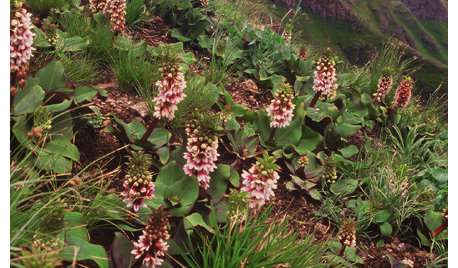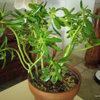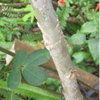For South Africa's Proteas, Change Is Not a Good Thing
By Cheryl Lyn Dybas, Washington Post

Global warming is coming to your living room, your dining room, your kitchen, anywhere you decorate with cut flowers.
Changes in climate and land use are killing a population of plants critical to the worldwide floral trade: proteas.
A recent study of hundreds of species of proteas that live only near Cape Town, South Africa, estimates that the plants' abundance will decrease by more than 60 percent by 2050. Some proteas will become extinct. Some already have.
When summer comes to Cape Town, proteas bloom in riotous color. On steep, rocky slopes strewn with lichen-covered chunks of granite, the flame-red and magenta-pink flowers dot the hillsides. They attract hordes of tourists and provide jobs for thousands of South Africans who gather proteas for the worldwide cut-flower industry.
With their vase-shaped bracts surrounding pencil-thin flowers, "proteas look like sea anemones," said Cheryl Andrews of Orlando, who uses proteas in the floral displays she designs for large hotels such as the Ritz-Carlton and JW Marriott. "Proteas are named for the Greek sea god Proteus, who could change his form at will. Indeed, there's a protea in any unusual shape you can imagine."
In the Washington area, "buyers attracted to exotic or tropical arrangements love South African proteas," said Neil Bassin, owner of Buckingham Florist in Arlington. "But these beautiful flowers might not be around much longer."
Proteas such as the king protea, which measures 12 inches across and is the national flower of South Africa, are under enemy fire. In a region where average temperatures have significantly warmed over the past 30 years and suburbs are sprawling up hillsides, Cape Town's most unusual flowers are besieged, said scientist Lee Hannah of Conservation International.
"In response, proteas are moving uphill themselves, to cooler spots with less development," said Hannah, who published results of a study of the effects of climate and land-use change on South Africa's proteas in the March issue of the journal BioScience. Some proteas are already extinct, said Hannah and Guy Midgley, a scientist at the South African National Biodiversity Institute in Cape Town.
Many species have such a tiny range that plowing a field or building a single house can wipe out the world population.
Hannah recently testified before the U.S. Senate Committee on Commerce, Science and Transportation on the impacts of climate change and land use on biodiversity. "I brought cut proteas with me to the hearing," he said. "It might have been one of the last glimpses of these flowers."
More than half of the world's several hundred protea species are threatened, Hannah said. Most live in South Africa, but there are several in Australia, and some have been transplanted to Hawaii's steep-sided volcanic slopes. South Africa has designated 35 proteas as "endangered with extinction" and 46 as "vulnerable to extinction." Another 76 are listed as "rare."
Proteas are the keystone species of South Africa's Cape Floral Kingdom, the smallest but, biologists say, richest of Earth's six plant kingdoms. The Cape Floral Kingdom, Hannah said, "is the size of a postage stamp, comparatively speaking. But it has the highest plant biodiversity anywhere on the planet Earth. About 8,000 plant species, three-quarters of which live nowhere else in the world, are found there, in what's called the fynbos ecosystem."
Leathery-leaved fynbos plants cover the mountains, valleys and coastal plains near South Africa's Cape of Good Hope. "Amazingly, proteas thrive in the nutrient-poor soils and high winds there," Hannah said.
In the continental United States , the sole place similar to the Cape Town fynbos ecosystem is near Fallbrook, Calif., north of San Diego. There, several protea growers are coaxing South African protea species into bloom. "It's much cooler here than elsewhere in the region," said Danielle Kendall, co-owner of Kendall Farms, which grows proteas on treeless hills resembling those of South Africa. "We have a similar soil type to that of the proteas' homeland and constant stiff ocean breezes."
One farmer in Fallbrook shuttles back and forth from California to Cape Town, tending proteas in both hemispheres.
For a short summer season, large evergreen protea shrubs are laden with flowers that, many visitors to South Africa say, might have come from a faraway galaxy. In fact, proteas came not from another place, but another time. They are remnants of the distant past, when Africa, Australia, India, South America and Antarctica existed as one landmass, called Gondwana.
Through the process of plate tectonics, Gondwana began to break apart about 130 million years ago. By 65 million years ago, about the time dinosaurs became extinct, the continents had divided into positions resembling their present-day configuration. Proteas once thrived on Gondwana; today members of the protea family live oceans apart.
The last of Earth's proteas grow in places known as hot spots, Hannah said. "Hot spots are regions with high numbers of plants and animals found nowhere else in the world, and that have had more than 70 percent of their natural habitat destroyed. The last thing these species-rich, high-habitat-loss areas need is another threat, but that's what climate change presents."
As Earth's climate warms, species will try to keep pace, moving to their preferred temperature ranges. Protea seeds are carried on the wind to new locations. Those that become rooted in cooler areas will survive.
"Climate change affects plants and animals," Hannah said, "when they can't move far enough to escape global warming." Of 300 species of proteas near Cape Town, the ranges of nearly all will have to shift by 2050, he said.
Conservation plans that allow species to relocate are an answer, Hannah believes. "It's something of a new idea, as most of our conservation efforts currently focus on parks, which are fixed in place. However, when a species starts to move, we need a 'park' not only where the species is today, but where it will be in the future. We also need protected 'connectors' that will allow it to get from point A to point B."
South African biologists involved in the Protea Atlas Project, an effort to collect information on Cape Town's proteas, are providing insights into how climate and land-use change will affect fynbos species, Midgley said.
Tony Rebelo, a biologist at the South African National Biodiversity Institute, said proteas were chosen as the best species for the project because they are easy to recognize and their distribution is similar to that of other major plant groups in the fynbos.
According to Rebelo, the Greek god Proteus could predict the future. However, Proteus did not willingly part with the information.
"He simply changed his shape and escaped," Rebelo said. "So we must grasp Proteus tightly this time and make sure that no more of our proteas become extinct."
Sherry Moretti, a floral designer at Bellagio, a hotel-casino in Las Vegas, agrees. "I wanted something breathtakingly gorgeous for Bellagio's opening a few years ago," she said. "On that special evening, proteas lined the entrance, bedecked the foyer, graced every table.
"I can't imagine an earth without proteas. They welcome you through the portal, and into another world."

















Heathen1
bruggirl
Related Discussions
Protea subvestita
Q
African Cherry Orange
Q
What is wrong with my african violet?
Q
Ideal Soil for Protea?
Q